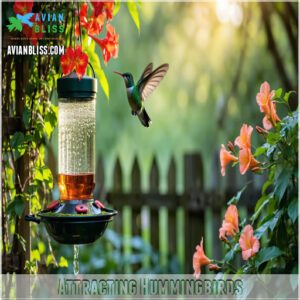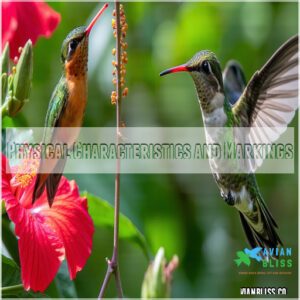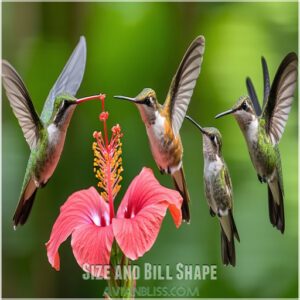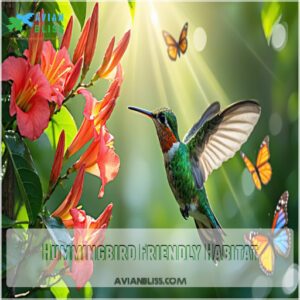This site is supported by our readers. We may earn a commission, at no cost to you, if you purchase through links.

The ruby-throated hummingbird is the star here, sticking around year-round, while others like the rufous hummingbird drop by during winter to escape the cold.
Rare visitors, including the black-chinned hummingbird and Bahama woodstar, add excitement to the mix.
You can attract these feathered gems by planting native flowers, setting up sugar-water feeders, and creating safe spaces with natural plants and fresh water.
Pay attention to their dazzling colors, unique beaks, and flight patterns—it’s like nature’s own air show!
Florida’s hummingbirds never disappoint.
Table Of Contents
- Key Takeaways
- Hummingbirds in Florida
- Hummingbird Migration Patterns
- Attracting Hummingbirds
- Hummingbird Identification
- Hummingbird Friendly Habitat
- Frequently Asked Questions (FAQs)
- How many types of hummingbirds are in Florida?
- What month are hummingbirds in Florida?
- How do I attract hummingbirds to my feeder in Florida?
- Do hummingbirds stay in Florida all year round?
- When do hummingbirds return to Central Florida?
- What time of year do hummingbirds come to Florida?
- Do hummingbirds live in Florida?
- Are hummingbirds in Florida year round?
- When can hummingbirds be seen in Florida?
- Which are the popular locations in Florida to spot hummingbirds?
- Conclusion
Key Takeaways
- You can spot ruby-throated hummingbirds year-round in Florida, while rare visitors like the Bahama woodstar and rufous hummingbird appear seasonally.
- Attract hummingbirds by planting native flowers like firebush and coral honeysuckle, setting up sugar-water feeders, and ensuring access to fresh water.
- Pay attention to unique traits like vibrant colors, flight patterns, and beak shapes to identify different hummingbird species in Florida.
- The peak times for spotting hummingbirds are from late February to September, with migration season bringing extra activity and variety.
Hummingbirds in Florida

Florida is home to several fascinating hummingbird species, from the common ruby-throated to rare visitors like Anna’s and Bahama woodstars.
You’ll often spot them in gardens, parks, and forests, where they feed on nectar and tiny insects, which makes these areas perfect for hummingbird viewing.
Ruby-Throated Hummingbird
The ruby-throated hummingbird, a star among Florida hummingbirds, is small yet mesmerizing.
It’s the only non-migratory species here, known for its vibrant ruby throat.
These Florida favorites thrive on a hummingbird diet of nectar and insects, fueling their incredible energy.
They’re known for their expert flight maneuvers.
Masterful in nesting habits, females craft tiny, camouflaged nests.
Spot this gem year-round–a highlight for hummingbird identification in Florida!
Rufous Hummingbird
If you’re lucky, you might spot the fiery Rufous Hummingbird in Florida during winter.
Known for their bold orange plumage, these tiny travelers stand out among hummingbirds of Florida.
Rufous hummingbirds breed farther north than other species, undertaking an impressive annual migration journey.
Here’s a quick glimpse at their charm:
- Feather color: Bright orange males, green-rusty females.
- Hummingbird diet: Nectar, insects.
- Rufous migration: Alaska to Mexico.
- Bird behavior: Aggressive, territorial.
- Nesting habits: Tiny cup-shaped nests.
Black-Chinned Hummingbird
The Black-Chinned Hummingbird, a rare visitor among hummingbirds of Florida, is fascinating to spot.
Found in habitats ranging from forests to suburban gardens, males flash a striking purple neck band, while females sport rounded tails.
For accurate identification, consider male hummingbird gorget colors.
Known for their long migration routes from Canada to Mexico, these hummingbird species thrive on nectar and flying insects, showcasing incredible feeding habits and adaptability.
Bahama Woodstar
The Bahama Woodstar is a rare gem among Florida hummingbirds.
This small species thrives in wooded and scrubby habitats.
Males flash a stunning iridescent purple throat and a long, forked tail.
To spot one:
- Look in coastal gardens during migration.
- Plant native flowers for its nectar-rich diet.
- Protect Woodstar habitats to support this endangered species.
Anna’s Hummingbird
Anna’s Hummingbird occasionally visits Florida during winter, making it a rare treat for birdwatchers.
These stunning hummingbirds dazzle with iridescent pink-red crowns, especially males.
To attract them, provide sugar water feeders, a key part of their hummingbird diet.
Spotting one at your feeder is no small feat—use the table below to improve your Anna’s habitat setup for success.
| Feature | Details |
|---|---|
| Color | Pink-red iridescence |
| Diet | Nectar, insects |
| Nesting Sites | Bushes, small trees |
| Conservation Status | Stable population |
Allen’s Hummingbird
Unlike the ruby-throated hummingbird Florida locals know well, Allen’s Hummingbird is a rare sight.
Known for its vibrant orange-red gorget and green back, this tiny species mostly stays along western migration routes.
Occasionally spotted among hummingbirds of Florida, it favors shrubs and open woods for nesting patterns.
Mastering hummingbird identification Florida enthusiasts often watch for its swift movements and territorial behavior, which are key to identifying the Allen’s Hummingbird.
Hummingbird Migration Patterns
Hummingbird migration patterns are like nature’s precise choreography.
Florida sees plenty of action, especially with ruby-throated hummingbirds.
These tiny flyers migrate thousands of miles, zipping between breeding grounds in the eastern U.S. and wintering spots in Mexico and Central America.
Researchers study migratory bird patterns to understand these incredible journeys.
Rufous hummingbirds take the crown for long-distance journeys, traveling from Alaska to Mexico but occasionally stopping in Florida.
In Clearwater, FL, and other coastal areas, migration peaks in March and September.
You’ll notice:
- Ruby-throated hummingbirds returning in early spring, following well-worn migration routes.
- Rufous hummingbirds appearing during winter with unpredictable seasonal movements.
- Black-chinned hummingbirds passing through rare habitat crossings.
- Altitude changes during long flights to navigate weather and geography.
Keep an eye out; these seasonal visits are unforgettable!
Attracting Hummingbirds
You can attract hummingbirds by creating a habitat that mimics their natural environment.
Add feeders with sugar water, native flowering plants, and fresh water to make your yard irresistible to these tiny birds.
Setting Up Hummingbird Feeders
If you’re serious about attracting hummingbirds in Florida, start with the right feeder placement—choose shady spots near flowers they already love.
You can find various hummingbird feeders online.
Stick to a simple hummingbird nectar recipe: one part sugar to four parts water. No dyes needed!
Clean feeders every 3-5 days to avoid harmful mold. Different feeder types guarantee plenty of space for these energetic birds.
Planting Native Flowers and Trees
Feeders are great, but native plantings are the real magnet for hummingbirds.
Boost your garden design with native Florida plants that overflow with nectar.
Try these:
- Firebush – A hummingbird favorite. Consider a firebush Florida native purchase.
- Coral Honeysuckle – Perfect for trellises.
- Powder Puff Trees – Eye-catching and nectar-rich.
- Bottlebrush Trees – Great tree selection.
- Salvias – Add vibrant flower choices.
Prepare soil well for thriving hummingbird plants Florida treasures.
Providing a Bird Bath
A simple bird bath can elevate your hummingbird gardens in Florida.
Go for a shallow bath, around an inch deep, ensuring pool safety for these tiny flyers.
Keep water clean—bird hygiene matters.
Gently dripping fountains attract them too.
You can find suitable hummingbird bath products online.
Clean baths weekly for feather care.
Combined with hummingbird plants Florida loves, you’re creating the perfect hummingbird habitat in Florida for stunning visitors.
Hummingbird Identification
When identifying hummingbirds in Florida, pay attention to their size, bill shape, and unique feather colors.
Look closely at markings like the ruby throat of the males or the green backs and white bellies of the females to tell them apart.
Physical Characteristics and Markings
When spotting hummingbird species in Florida, keep an eye on their feather colors and head markings.
Ruby-throated males boast a shimmering red throat, while black-chinned males flaunt a purple gorget.
Rufous hummingbirds dazzle with fiery orange tones.
- Beak shapes vary by species—long and slender.
- Wing patterns flash brilliantly in sunlight.
- Tail lengths help identify females.
- Distinct head markings make males stand out.
Size and Bill Shape
Hummingbirds may be tiny, but their size packs a punch. Most range from 2.8 to 3.5 inches in length, with a wingspan of 3.1 to 4.3 inches. Their unique flight abilities include hovering and backward flight. Their slender bills vary by species, curved or straight, designed perfectly for sipping nectar. Feather size and body mass influence their agility—key points in any hummingbird identification guide focused on beak length and bill shape.
Color and Plumage
Hummingbird colors are like nature’s highlighter, making them easy to spot.
The Ruby-throated Hummingbird boasts a vibrant, ruby-red throat, contrasting with green backs and white bellies.
Black-chinned males shimmer with iridescent purple throats, while females display subtler feather patterns.
Tail feathers vary too—bright, bold, and eye-catching.
Use a hummingbird identification guide to compare plumage types, iridescent colors, and even beak shades.
Hummingbird Friendly Habitat
Hummingbirds need habitats filled with native plants, bright flowers, and shelter to feel at home.
By creating a space with safe, natural elements like firebush and coral honeysuckle, you’ll attract these tiny visitors and support their survival.
Native Plants and Trees
Creating hummingbird gardens in Florida means focusing on florida native hummingbird plants.
Tree selection matters—native shrubs like coral honeysuckle offer great perches and nectar plants.
Smart garden design includes grouping flower choices like trumpet vine for year-round blooms.
Stick to native plants florida birds love, and pay attention to plant care so your flower gardens thrive as hummingbird havens with year-round blooms.
Firebush and Firecracker
Firebush plants and firecracker flowers are top-tier nectar sources for attracting hummingbirds in Florida.
Their bright reds and oranges stand out, fueling pollinator attraction while adding bold pops of color to hummingbird gardens.
These Florida native hummingbird attractors thrive in sunny spots, making garden designs simple yet effective.
For hummingbird nectar in Florida, these plants are irresistible hotspots that provide a bold display of color.
Coral Honeysuckle and Powder Puff Trees
If you loved firebush, coral honeysuckle is next on your list.
Its red, tubular flowers scream “hummingbird nectar Florida,” offering steady blooms for pollinator attraction.
Consider adding glorious hanging plants to further enhance your hummingbird haven.
Pair with powder puff trees, whose fluffy pink blossoms and rich nectar production make them must-haves for hummingbird gardens in Florida.
These Florida native hummingbird attractors thrive with simple tree care and proper flower selection.
Creating a Safe Environment
A safe hummingbird garden in Florida isn’t hard to create.
Protect nests by keeping outdoor cats indoors or adding deterrents like motion-activated sprinklers. Maintain feeders to prevent mold buildup, keeping hummingbird nectar fresh. Preserve habitat with native plants that attract hummingbirds naturally.
Here’s your checklist:
- Limit predators like cats.
- Clean feeders weekly.
- Plant native greenery.
Frequently Asked Questions (FAQs)
How many types of hummingbirds are in Florida?
Florida is home to 11 hummingbird species, from the common ruby-throated to rarer visitors like Anna’s and Costa’s.
You’ll mainly spot ruby-throated hummingbirds, but occasional winter visitors and rare sightings keep enthusiasts on their toes.
What month are hummingbirds in Florida?
Hummingbirds start arriving in Florida in late February to mid-March, with males leading the way.
They stick around until September, migrating south afterward.
Winter visitors, like rufous hummingbirds, can be spotted from September to April, and are part of the hummingbirds that visit the area during different times of the year.
How do I attract hummingbirds to my feeder in Florida?
Place feeders with a sugar-water mix (1 part sugar, 4 parts water) near red or orange flowers.
Clean feeders every 3-5 days, avoid dyes, and plant native blooms to keep them coming back.
Do hummingbirds stay in Florida all year round?
Ever wondered if those tiny, zipping jewels stick around all year?
Ruby-throated hummingbirds stay in Florida year-round, while others, like the rufous or black-chinned, are just seasonal visitors during winter.
Keep feeders ready!
When do hummingbirds return to Central Florida?
You’ll spot hummingbirds returning to Central Florida around late February to mid-March.
Males typically show up first, scouting for territories, with females following a week later, just as flowers start blooming for their nectar feast.
The timing of their arrival coincides with the blooming of flowers, which is crucial for their nectar feast.
What time of year do hummingbirds come to Florida?
Think birds would escape Florida heat? Nope, they’re smarter than we think.
Ruby-throated hummingbirds start showing up in late February, as migration kicks off.
By March, males arrive first, scouting nesting spots before females follow.
Do hummingbirds live in Florida?
Yes, hummingbirds live in Florida!
The ruby-throated hummingbird sticks around year-round, while others like black-chinned and rufous pass through in winter.
You’ll spot them darting between flowers, hunting nectar, and zipping through gardens.
Are hummingbirds in Florida year round?
You’ll find hummingbirds in Florida all year, but only the ruby-throated species stays permanently.
Others, like rufous and black-chinned hummingbirds, appear mainly in winter.
Look for them in gardens, suburbs, and open woodlands.
When can hummingbirds be seen in Florida?
It’s almost unfair how fleeting their visits can seem!
You’ll see hummingbirds in Florida from late February through September, with ruby-throated hummingbirds sticking around year-round, especially in central and northern areas during winter months.
They are particularly notable for being present year-round in certain areas.
Which are the popular locations in Florida to spot hummingbirds?
You’ll spot hummingbirds in Florida at parks like Everglades National Park or Paynes Prairie Preserve.
Keep an eye on gardens with tubular flowers or feeders in suburban areas—especially during migration season from March to September!
Conclusion
How can you resist the charm of the hummingbirds of Florida?
These tiny marvels, from ruby-throated regulars to rare visitors like the Bahama woodstar, bring life to your garden.
By planting native flowers, setting up feeders, and offering fresh water, you’ll create a haven for these aerial acrobats.
Keep an eye on their vibrant colors, unique bills, and fast-fluttering wings—they never fail to impress.
With patience, you’ll witness Florida’s most dazzling winged wonders up close!
- https://edis.ifas.ufl.edu/publication/UW059
- https://baysoundings.com/hummingbirds-in-florida-if-you-plant-it-they-will-come/
- https://avibirds.com/hummingbirds-of-florida/
- https://www.news-press.com/story/news/2024/02/27/florida-hummingbird-season-birds-spring-migration/72741072007/
- https://www.lawnmoregainesville.com/blog/how-to-attract-hummingbirds-in-florida







